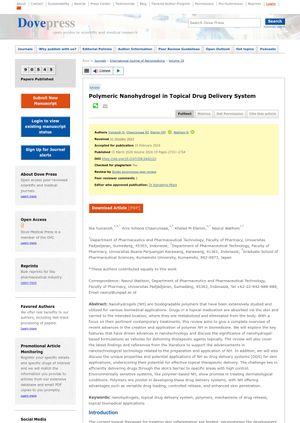Polymeric Nanohydrogel in Topical Drug Delivery System
March 2024
in “
International journal of nanomedicine
”

TLDR Polymeric nanohydrogels show potential for skin drug delivery but have concerns like toxicity and regulatory hurdles.
The document discusses the use of polymeric nanohydrogels (NH) in topical drug delivery systems. NH are viscoelastic, hydrophilic polymeric networks within the sub-micron size range, used as nanocarriers in drug delivery. They offer several advantages such as active ingredient protection, biocompatibility, versatile drug formulation, stimuli-responsive properties, and enhanced bioavailability. However, they also have potential drawbacks like tissue toxicity and severe polymerization reactions. NH have shown promise in various biomedical applications, including drug delivery systems, wound dressings, tissue engineering, and regenerative medicine. They have been used to deliver various drugs and natural compounds for the treatment of different conditions, including psoriasis, arthritis, melanoma, cutaneous leishmaniasis, rheumatoid arthritis inflammation, and skin cancer. Importantly, nanogel formulations of finasteride have been developed for the topical treatment of androgenetic alopecia, showing potential in the management of this condition. Despite the promising preclinical data, concerns related to toxicity, immunogenicity, and regulatory challenges need to be addressed for successful clinical translation.





